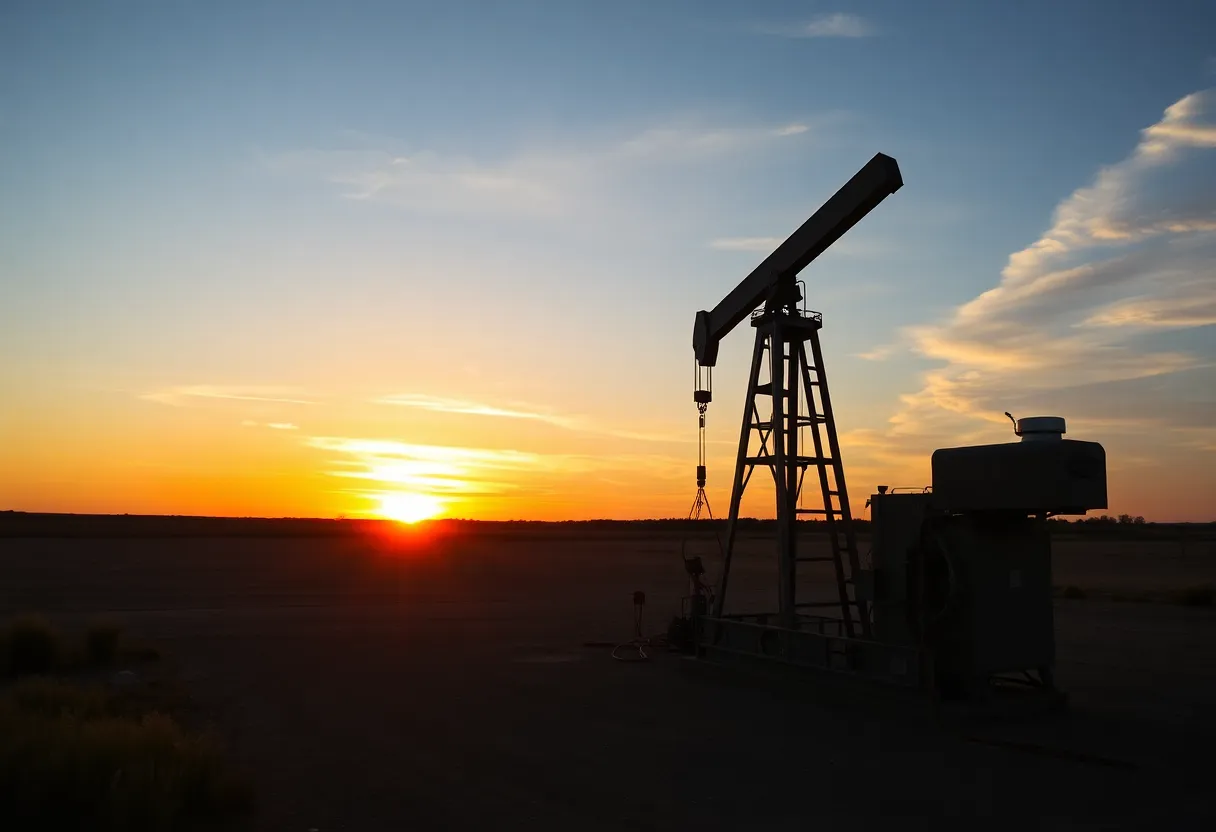Oklahoma City, October 5, 2025
Oklahoma’s oil sector celebrates a significant milestone as crude oil prices soar to $85 per barrel. This surge boosts profits for companies like Devon Energy and generates an additional $300 million in state revenues, further driving economic growth and job creation in the region. However, environmental concerns arise amidst increased drilling activities, highlighting the balancing act between economic prosperity and sustainability.
Oklahoma City
Oklahoma’s oil industry has reached a significant milestone with crude oil prices climbing to $85 per barrel, driving up profits for major companies like Devon Energy based in Oklahoma City. This surge has boosted the state’s energy sector, with production in the Anadarko Basin increasing by 8% compared to the previous year. The rise is largely due to advanced drilling technologies that improve efficiency and output.
The financial windfall extends beyond corporate earnings. It has injected an additional $300 million into state revenues, providing funds for essential infrastructure projects across Oklahoma. Local suppliers in the oil supply chain are experiencing a boom, with record orders leading to the creation of 2,000 new jobs. This expansion highlights the immediate economic benefits rippling through communities tied to the energy industry.
While the growth brings opportunities, it also sparks debate. Environmental groups have voiced concerns about the potential for higher emissions from increased drilling activities. These worries underscore the ongoing tension between economic gains and environmental sustainability in the oil sector.
Impact on Production and Technology
In the Anadarko Basin, a key oil-producing region in western Oklahoma and parts of Texas, output has grown steadily. The 8% year-over-year increase stems from innovations in drilling technology, such as enhanced hydraulic fracturing methods and improved seismic imaging. These advancements allow companies to extract more oil from existing wells, reducing costs and environmental footprints per barrel produced. Devon Energy, headquartered in Oklahoma City, has been at the forefront of adopting these technologies, contributing to its elevated profits amid the price hike.
The higher oil prices, reaching $85 per barrel, reflect global demand and supply dynamics. This level marks a strong recovery point for the industry following earlier market fluctuations. For Oklahoma, which relies heavily on oil and gas for its economy, the milestone reinforces its position as a vital player in the U.S. energy landscape.
Economic and State Revenue Boost
The $300 million in additional state revenues from this oil price surge offers a timely boost. Oklahoma plans to allocate these funds toward infrastructure improvements, including road repairs and energy-related developments. Such investments are expected to support long-term growth and job stability in the region.
Local suppliers, from equipment manufacturers to service providers, report unprecedented demand. This has directly resulted in 2,000 more workers being hired, easing unemployment in oil-dependent areas. The job growth not only aids families but also stimulates local businesses, from housing to retail, creating a broader economic uplift.
Environmental Concerns and Future Outlook
Not all aspects of this milestone are celebrated equally. Environmental groups point to the risks of increased emissions from ramped-up production. Higher drilling activity could exacerbate air and water quality issues, prompting calls for stricter regulations to balance growth with conservation efforts. Oklahoma’s oil industry faces pressure to incorporate greener practices, such as carbon capture technologies, to mitigate these impacts.
Analysts forecast that oil prices will remain stable through 2026, provided there are no major geopolitical disruptions. This prediction offers reassurance for sustained profitability and production. However, the industry remains sensitive to international events, such as conflicts in oil-producing regions or shifts in global energy policies.
Oklahoma’s role in the U.S. energy markets is pivotal, with the state contributing significantly to national oil supply. The current boom exemplifies how local developments can influence broader economic trends, while also highlighting the need for responsible management of resources.
Broader Implications for the Energy Sector
The milestone comes at a time when the U.S. energy sector is navigating a transition toward renewables. Yet, oil’s dominance persists, especially in states like Oklahoma where it forms the economic backbone. The 8% production rise in the Anadarko Basin demonstrates resilience, but it also raises questions about diversification. Companies like Devon Energy are investing in both traditional and alternative energy to hedge against future uncertainties.
For residents and businesses in Oklahoma City, the effects are tangible. Increased revenues could lead to better public services, while job growth supports community vitality. At the same time, environmental advocacy pushes for sustainable practices to ensure long-term viability.
This oil price milestone serves as a reminder of the industry’s cyclical nature. Past booms have brought prosperity, followed by busts tied to price drops. With stability projected through 2026, Oklahoma’s energy sector has a window to build on current gains, addressing both economic and ecological challenges head-on.
Frequently Asked Questions
What milestone has Oklahoma’s oil industry recently celebrated?
Oklahoma’s oil industry celebrated a milestone as prices hit $85 per barrel, boosting profits for majors like Devon Energy in Oklahoma City.
How has production changed in the Anadarko Basin?
Production in the Anadarko Basin rose 8% year-over-year, with new drilling tech enhancing efficiency.
What financial impact has the oil price surge had on the state?
The surge adds $300 million in state revenues, funding infrastructure projects.
What concerns have environmental groups raised?
However, environmental groups raise concerns over increased emissions.
How has the local economy been affected by supplier activity?
Local suppliers report record orders, employing 2,000 more workers.
What is the predicted outlook for oil prices?
Analysts predict stability through 2026, barring geopolitical shifts.
What does this milestone indicate about Oklahoma’s energy role?
This windfall underscores Oklahoma’s pivotal role in U.S. energy markets.
Key Features Chart
Below is a simple table outlining the key features of Oklahoma’s recent oil industry milestone:
| Feature | Details |
|---|---|
| Oil Price Milestone | Prices hit $85 per barrel, boosting profits for majors like Devon Energy in Oklahoma City |
| Production Growth | Production in the Anadarko Basin rose 8% year-over-year, with new drilling tech enhancing efficiency |
| State Revenue Impact | The surge adds $300 million in state revenues, funding infrastructure projects |
| Environmental Concerns | Environmental groups raise concerns over increased emissions |
| Employment Boost | Local suppliers report record orders, employing 2,000 more workers |
| Price Outlook | Analysts predict stability through 2026, barring geopolitical shifts |
| Strategic Role | This windfall underscores Oklahoma’s pivotal role in U.S. energy markets |





